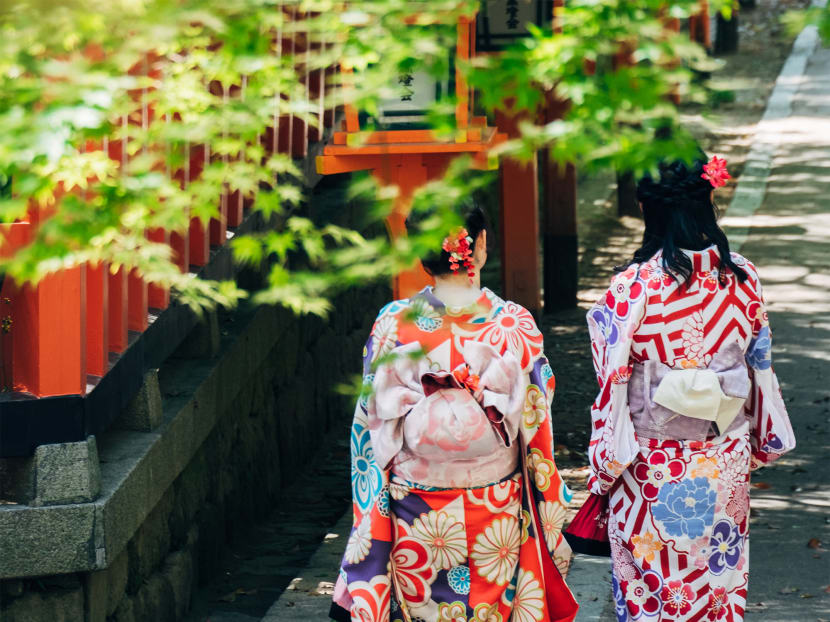Kyoto targets badly behaved tourists with smartphone alerts on local manners
HONG KONG — Foreign visitors to a popular sightseeing spot in the Japanese city of Kyoto will now be reminded of etiquette via their smartphones in a pilot project launched on Monday (Sept 30), after local residents complained of badly behaved tourists.

Foreign visitors to a popular sightseeing spot in the Japanese city of Kyoto will now be reminded of etiquette via their smartphones.
HONG KONG — Foreign visitors to a popular sightseeing spot in the Japanese city of Kyoto will now be reminded of etiquette via their smartphones in a pilot project launched on Monday (Sept 30), after local residents complained of badly behaved tourists.
The programme has been implemented around the “Hanamikoji” street in Kyoto’s Gion district, renowned for its tea-houses and other historic buildings. Visitors who have installed a tourist information app or carry mobile devices rented from hotels and inns automatically will receive information about local manners in English and Chinese.
“It’s complicated,” admits Mr Kei Tamura, who lives in the city and is a director of Cerca Travel. “Tourists have had a huge positive impact on local businesses and we believe that their experiences are helping to promote Kyoto around the world. But, on the other hand, there are people here who say it has already gone too far, that there are simply too many tourists in the city and the local infrastructure cannot cope.”
The project, which will run until Dec 8, was launched by the Land, Infrastructure, Transport and Tourism Ministry in cooperation with the Kyoto city government.
Foreign visitors have earned an unsavoury reputation in recent years: buses around most popular sites have become too busy for local residents to use and the crowds outside famous attractions make it difficult to navigate parts of the city.
In a survey about tourists’ behaviour circulated last year among local residents, bars and restaurants, members reported seeing visitors “sit and lie on the streets to take pictures” and foreigners chasing geisha and their maiko apprentices with cameras.
Visitors staying in the city are often unaware of local customs, such as the way household rubbish is meticulously separated for recycling, causing friction with residents. There have also been complaints about noise and loud music at night in rental accommodation and a general disruption of the city’s low-key atmosphere.
Demand for accommodation has also encouraged some landlords to lease out properties despite them not being licensed by local authorities, deepening local resentment of the tourism industry.
A page on the Kyoto city travel website urges visitors not to walk while staring at their mobile phones, to be careful of others when carrying bags, to exercise caution when riding rental bicycles, to follow road traffic rules, to refrain from smoking on the street and to take precautions against heatstroke in summer. Tourists have also been advised to not enter private properties.
Japan has become hugely popular as a tourist destination in the past decade, and Kyoto has become a must-see for many visitors. In 2017, there were 53.6 million domestic and foreign visitors to Kyoto, with 3.53 million foreigners spending at least one night in a Kyoto hotel.
According to the latest statistics from the Kyoto City Tourism Association, 4.5 million foreign visitors spent at least one night in a hotel in the city in 2018. Of that total, more than 1.17 million were Chinese.
To better control the volume of tourists, Mr Tamura suggests the introduction of a “passport” to visit Kyoto. New arrivals would be issued with the travel document for a small fee, which would be invested into the city’s infrastructure. The “passport” would also include pamphlets detailing local customs, etiquette and how foreigners can avoiding upsetting residents.
“I don’t want Kyoto to be outside of Japan, but I’m looking for a way to make it exceptional within Japan,” Mr Tamura says. “We have to find a way to limit numbers so we no longer have disharmony between visitors and locals – and we need to do it soon because this is a small city and there are already too many people here.
“My belief is that we need to find the right balance for both the tourists and local people.” SOUTH CHINA MORNING POST






